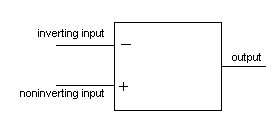

| The difference
amplifier has two inputs and one output.
It amplifies the difference between the voltages at the two inputs. If the voltage on one input is 10 mV and 15 mV on the other then the difference is 5 mV. If the amplifier amplifies by ten times then the output voltage will 5 mV times 10 which equals 50 mV. If the two inputs
are joined together and a voltage applied to them, then the voltage on
both inputs will be the same. There is no difference between them and there
will be no output from the amplifier.
If, when being
used as a difference amplifier, there is some interference picked up by
both inputs, the interfering signal will not appear at the output because
both input signals are the same.
|
